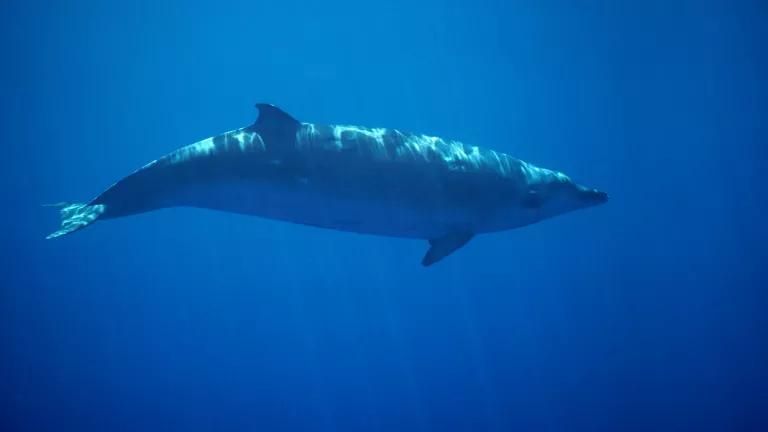A Whale of a Win
The U.S. Navy finally agreed to stop conducting harmful sonar drills in certain areas where whales migrate and breed—it only took two decades' worth of courtroom battles.

A beaked whale off the coast of Hawaii
“It’s so loud, I can’t even hear myself think.” We often use that phrase when bothersome noises around us—construction, music, car alarms—disrupt our concentration. Frustrating? Sure. Headache inducing? Probably. But imagine if that racket also interfered with your ability to eat, reproduce, communicate, and navigate—and you had no way of escaping it.
That’s the harsh reality for whales, dolphins, and other marine mammals that rely on their acute sense of hearing for basic life functions. Tens of thousands of supertankers, their engines and propellers blaring, traverse across our oceans and, in some areas, companies on the hunt for oil and gas repeatedly blast underwater seismic airguns—sounds loud enough to make marine creatures’ ears bleed. And off the shores of the United States, whales and dolphins face yet another sonic threat: high-intensity sonar used in training exercises by the U.S. Navy. Numerous studies have shown that these sound waves that detect submarines and other underwater objects also cause whales and dolphins to temporarily—and sometimes permanently—lose their hearing, abandon their feeding areas, stop communicating or breeding, and even strand themselves.
Since the mid-1990s, NRDC has been working to silence those harmful sounds and urging the navy, in particular, to reduce its impact on marine mammals. It hasn’t been an easy task. “The navy is one of the most powerful agencies in the U.S. government,” says Joel Reynolds, senior attorney and NRDC’s Western director. “It has institutional momentum that is second to none. They like to do things the way they’ve always done things, even if it’s not the right way.”
In March 2015, after a series of lawsuits filed by NRDC over more than 20 years, whales scored a major legal victory. A federal judge ruled that the navy’s training activities caused marine mammals off the coasts of Southern California and Hawaii illegal harm under the Marine Mammal Protection Act, the Endangered Species Act, and the National Environmental Policy Act. And by September of that year, NRDC and the U.S. Navy reached a settlement agreement: For the first time ever, the navy agreed to cease conducting exercises in important habitat for a range of vulnerable ocean species.
What made this case different? Both Reynolds and Jen Sorenson, an NRDC attorney who helped litigate the case, say new and more comprehensive research on just how much high-intensity sonar can harm marine mammals played a big role in the favorable ruling.
For example, recent studies have shown that Southern California's population of beaked whales are especially sensitive to sonar. The whales flee certain areas during sonar exercises and therefore miss out on substantial amounts of food, making them weaker and less likely to reproduce. As a result, the beaked whale population is declining. “These are the subtle effects that people weren’t necessarily aware of five years ago,” Sorenson says.
NRDC's lawsuit, which concerned the U.S. Navy’s most recent five-year plan (2013–18) for training and testing, also showed just how little government oversight was being given to the problem. Every five years, the navy applies for a new permit from the National Marine Fisheries Service, or NMFS, which is supposed to ensure the navy's activities would have a “negligible impact” on marine mammals. But in the authorization, NMFS permitted up to 155 mortalities and an unbelievable 9.6 million incidences of temporary injury or behavioral disruptions. “It shows the blatant flaws in the National Marine Fisheries Service's analysis,” Sorenson says.
And in her March 2015 ruling, then-U.S. District Judge Susan Oki Mollway agreed. She criticized the U.S. Navy’s “failure to clearly consider important information” and concluded that its “categorical and sweeping statements, which allow for no compromise at all as to space, time, species, or condition, do not constitute the 'hard look required' by federal law.”
Her decision proves what NRDC has known all along: We can protect our national security while also safeguarding marine mammals. The two are not, as the navy has argued for decades, mutually exclusive.
This victory establishes a critically important precedent, but the settlement agreement applies only to areas off the coasts of Southern California and Hawaii—and involves only the permit that ends in 2018. Meanwhile, the U.S. Navy continues to test and train with high-intensity sonar in other places off our shores, and whales, dolphins, and other sea mammals continue to suffer the consequences. NRDC is now working to permanently protect the areas in California and Hawaii and to establish similar sonar-exclusion areas in the Atlantic, Pacific Northwest, and Gulf of Alaska.
So NRDC has won a big battle but not the war, which will persist until there's a clear-cut solution to high-intensity sonar and ocean noise pollution. “Like so many environmental problems, it’s ongoing,” Reynolds says. “Until a new technology that doesn’t depend on sound is developed and deployed, we just have to keep winning.”
This NRDC.org story is available for online republication by news media outlets or nonprofits under these conditions: The writer(s) must be credited with a byline; you must note prominently that the story was originally published by NRDC.org and link to the original; the story cannot be edited (beyond simple things such as grammar); you can’t resell the story in any form or grant republishing rights to other outlets; you can’t republish our material wholesale or automatically—you need to select stories individually; you can’t republish the photos or graphics on our site without specific permission; you should drop us a note to let us know when you’ve used one of our stories.

Hawaii Stands Up for Its Sharks With Fishing Ban
Facing Down the Ivory Sellers, Pangolin Poachers, and Giraffe Traders
This Lawyer Is Fighting to Save Two of the World’s Most Endangered Species